| The della Scala Family in
Northen Italy |
| In
the late 12th century, one Jacopino della Scala
(d.1215) appears in the historical record as an
Italian wool trader. By astute networking, he
became Imperial Vicar in Ostiglia and Podestà
(high ranking official) of Cerea, both places
near Verona in Northern Italy. It seems that he
can be traced back to his great-grandfather
Balduino della Scala (d.aft.1169) and that he is
a distant ancestor of King George I of England
and Winston Churchill. |
| We
have discussed earlier how the noble Scales
line in England derived from the Norman Hardwin
de Scalers, whose was Hardouin
d’Escaliers in the original French. In
Latin documents this was rendered Scalariis
or Scalis. The name is Scandinavian in
origin (from the original Norse skáli). The Latin
form of the della Scala family name was also
rendered de Scalis. A common origin of
the Norman and Italian names therefore seems a
strong possibility. |
| Scala
means staircase or ladder in
Italian and the family adopted the ladder as an
emblem purely because of this homophonic
connection. Escalier
is also the French for staircase and Scalae
the Latin for staircase or ladder. The connection exists in
English as well, scale meaning to rise
in steps (e.g. up a mountain) or an incremental
measure (e.g. in music). |
| Scandinavian Origins |
| The
della Scala family were of German origin and,
more precisely, of Lombard stock, who in turn
were of Scandinavian origin. A German form of the
name, common today, is Schaller. The della
Scala name, like the Scales name,
can therefore be traced back to the same
Scandinavian origins. |
| The
Lombards originated in southern Scandinavia and
occupied parts of northern Germany in the early
Christian era. By the end of the 5th century,
they had reached the Danube, where they faced a
number of wars with the local tribes. They were
finally victorious in 552 under their king
Audoin. He led his people almost unopposed into
northern Italy, which had been left severely
depopulated by the Gothic War (535-554).
By 572, they had conquered all of the Italian
cities north of the river Po and established a
Lombard Kingdom. At its zenith in the 8th century
under its ruler Liutprand, this included parts of
central and southern Italy. However, they were
pushed back to the margins in 774 following
defeat by the Franks under Charlemagne. |
| The Lords of Verona |
| It
wouldn't have been quite so interesting to pursue
the della Scala connection were it not for the
fact that the family, beginning with Jacopino's
son Mastino I (1260-1277) are of considerable
historical significance. Mastino was elected
Podestà of Verona, an office tranformed into a
permanent lordship by his predecessor. Mastino in
turn made the position a family inheritance in
1263 and thus were born the Lords of Verona.
The family name became the more germanic Scaliger
or the Scaligeri. |
| Mastino
II (1329-1351), great-great-great-grandson of
Mastino I, was the richest and most powerful
prince of his generation in Italy. At the peak of
his power in 1336, he held a vast swathe of
northern Italy, including the cities of Belluno,
Treviso, Vicenza, Padova, Verona, Brescia, Parma
and Lucca. By 1340, he had lost it all, apart
from Verona and Vicenza, in a war against a
league of his powerful neighbours to the south. |
| The
Scaliger line descended through six more Lords of
Verona to Antonio I (1362-1388). In times that
were generally pretty bloody anyway, these latter
lords outdid themselves in tyrannical behaviour
and a series of fratricides. One of the
murderers, Cansignorio (1340-1375), did at least
beautify Verona with palaces, bridges and
aqueducts. Antonio's behaviour proved his
downfall when Gian Galeazzo Visconti (1351-1402),
1st Duke of Milan, made war on Verona and the
Veronese people deserted him, putting an end to
the Scaliger domination
in 1387. Antonio fled to his his wife's father's
dominions in Ferrara and Ravenna where he died in
1388. The line ended when his son died before
becoming a teenager. |
| Of the
remaining della Scalas, some non-noble
descendents of cadet lines remained in Verona.
Nothing further is known of them. The longest
surviving branch consisted of the descendents of
Cangrande II, who took advantage of their
friendship with the Wittelsbach family in
neighbouring South Tyrol and took refuge at the
court of the future Emperor Sigismond. In 1404,
the family failed in a bloody attempt to
recapture Verona. Several family members held
important ecclesiastical and administrative posts
in Germany and Italy in the early 15th century. |
| The family
remained loyal to the Emperor throughout the 15th
century and held important positions at court as
counsellors, deputies, administrators and
diplomats, always dreaming of returning to
Verona. Some changed their name to the vernacular
von der Leiter. In the early 16th century,
the family was involved in Emperor Maximilian I's
territorial ambitions in northern Italy, which
had no lasting success. A certain Giovanni
Teodorico della Scala died in 1598. On his tomb
is inscribed: last of the descendents of the
della Scala family, died aged 27 without leaving
any heir. It appears unlikely that any of
this branch of the family survived into the 17th
century. For more information, see Associazioni Culturali Scaligeri. |
| The
church of Santa Maria Antica in Verona is
adjacent to the elaborate gothic tombs of some of
the Scaligeri, principally those of Cangrande I,
Mastino II and Cansignorio. Mastino is the
Italian for mastiff, and the family seem
to have had a thing about dogs. Cangrande
continued the obsession. Can comes from
the eastern Khan (showing Marco Polo's
influence) and so Cangrande means great ruler
but also top dog. His tomb is supported
by two dogs bearing the Scaliger ladder insignia.
The family seem to have had a thing about puns
too. |
| |
 |
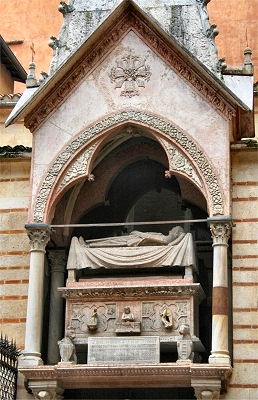 |
| Statue
and Tomb of Cangrande I in Verona |
 |
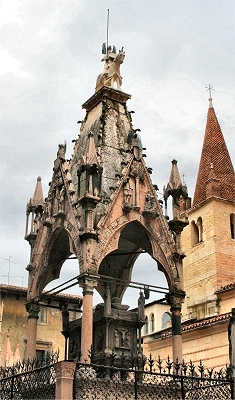 |
| Tombs
of Cansignorio (left) and Mastino II (right) in
Verona |
| |
| La Scala in Milan |
| The famous
La Scala opera house in Milan has a connection
with the della Scala family of Verona. In 1350,
Beatrice Regina della Scala, daughter of Mastino
II, married Bernaḅ Visconti, Lord of a number
of territories around Verona including Bergamo,
Brescia and Cremona. Bernaḅ was born in Milan
and became Lord of Milan in turn with his two
brothers. The marriage for a time provided an
important political and cultural alliance between
Milan and Verona. Beatrice was patron of the church of Santa Maria
della Scala, built in Milan in 1381 and
named in honour of her, despite the fact that her
husband was hated by the Milanese and held, in
common with the della Scala family, a fierce
antipathy towards the Pope. The square in front
of the church became known as the Piazza
della Scala. The church was demolished in
1778 to make way for the present building, known
as the Teatro alla Scala after the
square on which it is situated. I am grateful to
Giorgio Arduini, who wrote to me from Italy
informing me of this connection with the family. |
|
 |
| Sirmione
Castle |
| Mastino
I was probably the founder of the beautiful
castle at Sirmione on the southern shore of Lake
Garda. There are three other major Scaliger
castles on the lakeside. Inverted V-shaped
turrets feature on many of the buildings of the
Scaliger family and symbolise inverted pope's
mitres. The German origins and sympathies of the
Scaliger family lead to their being on the side
of the Holy Roman Emperor and antagonistic
towards the Pope. |
| |
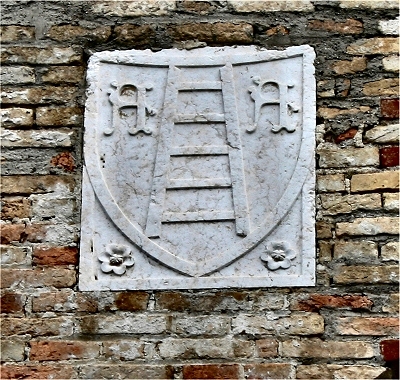 |
| Ladder
Insignia of the Scaliger Family at Sirmione
Castle |
| |
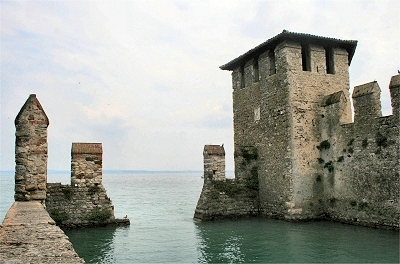 |
| The
Mediaeval Port at Sirmione |
| This
is a rare surviving example of mediaeval port
fortifications, provided for the Scaliger fleet
on Lake Garda. |
| |
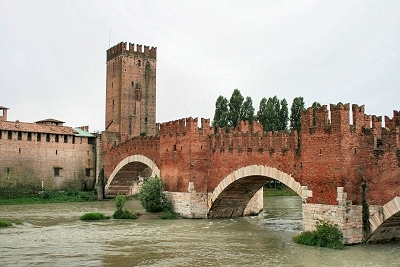 |
| The
Castelvecchio and the Ponte Scaligero in Verona |
| The
Castelvecchio and its fortified bridge were
constructed by Cangrande II della Scala in
1354-76. The castle is imposing and very austere.
The bridge (1354-56) contained the world's
largest span at the time of its construction. Its
was designed to provide a safe exit northwards in
the event of any trouble. It was destroyed by
retreating German troops in 1945 and
reconstructed in 1949-51. |
| |
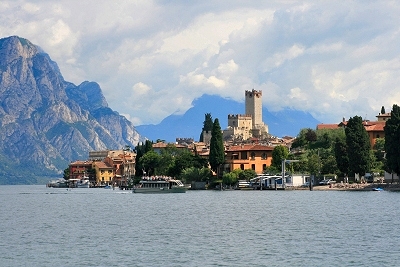 |
| Malcesine
and the Scaliger Castle on Lake Garda |
| |
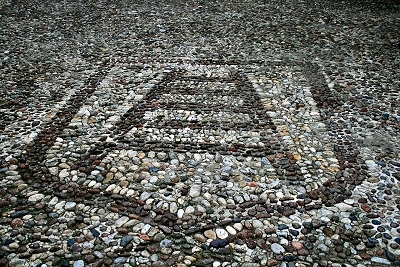 |
| Ladder
Insignia of the Scaliger Family at Malcesine
Castle |
| |
| The Hispanic Connection: de la
Escalera |
| I was
alerted to a Hispanic connection for the family
name by Petr Solar of the Czech Republic. His
ancestors (presumably Lombardic in origin) were
called Schaller and emigrated to Bohemia
from Bavaria. Using DNA matching, he has located
a relative in Spain with the name de la
Escalera (Escalera is Spanish for stairs
and ladder, by the way). The connection
with the Norman French d’Escaliers and the
Italian della Scala is striking. The name may have
arrived in Spain from the Lombards in Germany or
Italy. |
| I discovered
a nice little addendum to the Santa Maria
della Scala story while looking into the
Hispanic connection: the Virgen de la Escalera. It seems that there is a
mysterious chapel underneath a staircase inside
the old fort of San Juan de Ulua at the port of
Veracruz in Mexico. The chapel was apparently
dedicated to Our Lady of the Stairway,
who was thought to offer protection to sailors. I
refer you to the website for further information. |
|